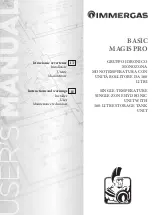
INSTALLATION
11
4.
INSTALLATION
4.1.
Hydraulic connections
The boiler is intended for connection with an open expansion vessel network. The boiler can be
connected also with closed expansion vessel, if it is equipped with an overheating serpentine
(optional).
The boiler is intended for maximum working temperature 90
o
C and maximum pressure 2 bars.
When connected with a closed expansion vessel, its volume must be chosen double to a similar
installation on liquid or gas fuel.
If a connection pipe is not used, it must be sealed before water fill!
4.2.
Return temperature protection
For the correct function of the boiler and for protection against corrosion it is very important to
ensure steady temperature at the return of the boiler of at least 55
o
C.
This can be ensured by installing a recirculation pump between the boiler outlet and return (see
connection diagrams).
An alternative variation is by installing at the return of the boiler a three-way thermostatic valve.
Having a return temperature less than 55
o
C is very dangerous for the boiler long-
life and can cause warranty loss!
4.3.
Filling the system
After completing all the hydraulic connections, the circuit may be filled with water. After filling
the system, open the radiators air valves to get rid of the air in the installation.
Verify that the installation pressure is according to the technical feature of the boiler. The
pressure must be verified through the boiler’s manometer. An additional manometer should be
installed on the cold water inlet to verify the cold pressure, at the lowest point of the installation,
at a point close to the boiler.
The whole installation must remain under nominal pressure for at least 10 minutes. During this
period, check that all the connections are tight and there are no water leakages. Make sure that
during this period no pressure drop appears.
Legend
T1 Outlet
T2 Return
T3 Chimney pipe
T4 Safety kit connection
T5 Discharge valve connection












































